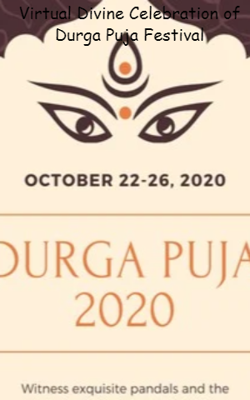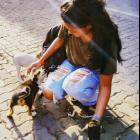Virtual Divine Celebration of Durga Puja Festival
Virtual Divine Celebration of Durga Puja Festival


Durga puja is one of the grandest and spectacular festivals in India. Not only Bengal, but all religions celebrate this festival with joy and fervor. It is celebrated as “Navratri” in most parts of the country. Although this festival lasts for 10 days, the main rituals for Durga puja start from the sixth day till Vijaya Dashmi. As per the Gregorian calendar, ‘Sharodiya’ basically takes place in October. As per the Bengali calendar, it takes place in ‘Ashwin’, when “Saccharum Spontaneum”, a white-colored beautiful grass (also known as kans/kash) is seen everywhere in the neighborhood. This signifies that Durga puja is just around the corner.
Here are the glimpses of this celebration:
Maha PanchamiAs per the ritual, the priest observes fast, abstaining from meat and any form of intoxication. Many people offer prayers (tarpan) to their ancestors so that their souls rest in peace. This is the fifth day of Navratri celebrations when the preparations for the festival begin.
Significance of Durga PujaIn Bengal, the first day of Durga puja is known as “Mahalaya”, starting from “Devipaksha” to the end of Dashmi or ‘Dusshera’. People wake up at 3:30 am to listen to the broadcast of “Chandi Kavya” by Birendra Krishna Bhadra over the radio. His enchanting voice echoes in every corner of the house, leaving them mesmerized and nostalgic. This marks the descent of Durga Maa to Kailash hills, along with her five children. On this day, the priest places a ghot (an earthen pot) at the entrance of the pandal, along with an idol and banana trees draped in a white saree with a red border. More ghots are placed until Panchami.
Day 1: Maha SasthiThe sixth day of Navratri is called ‘maha sashthi’. Adhivash puja is performed in the evening. Devotional hymns are chanted. The face of Maa Durga is finally uncovered, which is opened by ‘amantran’, ‘bodhan’ and ‘adhibash’ with the rhythmic beating of dhak (a kind of drum).
The importance of dhak and the rhythmic style played by dhakis is an integral part of the five-day-long festival.
Pandal Hopping
From sasthi to navami, millions of people gather to visit the pandals and idols decorated by the designers. The crowd can be seen everywhere in Kolkata. Various types of stalls are located near the pandals. Everyone is busy clicking photos and rejoicing the festive occasion.
Day 2: Maha SaptamiThe seventh day is known as “Maha Saptami”. The most important part is the bathing of Lord Ganesha’s wife, “kola bou” or “nabapatrika”. Nine types of plants are tied together representing different forms of Goddess Durga. Some married ladies are taken to the nearest pond for bathing. The women blow conch shells when the bathing takes place. After finishing the bath, kola bou is placed and worshipped near the idol of Ganesha and Maa Durga.
The Speciality of Khichdi Bhog
From shashthi to dashami, khichdi prasadam plays an integral part in the festival of Durga puja. The bhog/prasad is first offered to the Goddess Durga. After Anjali, the bhog is distributed to all the devotees.
Day 3: Maha AshtamiThe eighth day of Durga festival is called “Maha Ashtami”. On this day, the girls are dressed up like different goddesses, wearing beautiful jewelry and costume. The priest chants shlokas and hymns and one little girl is worshipped like Maa Durga. This is known as ‘kumari puja’. After the puja, people touch her feet and she gives them blessings.
“Pushpanjali” is arranged every day during this celebration. All young and old people observe fast and make arrangements for worshipping Devi Maa. She is offered 108 lotuses and an equal number of earthen lamps are lighted during this ritual. This is called “sandhi puja”. At the end of the day, the prasad is distributed to all the devotees.
Day 4: Maha NavamiThe auspicious day beginning right after the ending of the Sandhi Puja is called “Maha Navami”. On this day, the execution of ‘Maha Aarti’ is played by rhythmic beats of dhak. A long arrangement of puja like ‘maha yagna’ and homa is done in the morning session after anjali.
Day 5: Dashami and Sindoor KhelaDurga puja ends on the tenth day. In the morning, ‘visarjan puja’ is done by the priest by sprinkling water from the river Ganges, which is called ‘shanti jal’. Then “sindoor khela” is arranged and all married women take part in this by splashing colors on each other. Sindoor khela is the main part of Dussera. People worship Durga Maa by offering betel nuts, sweets, and sindoor (vermillion).
In the evening, the procession is organized by the members and decorated with magnificent lights and DJ arrangements. People dance, enjoy and take the idols for immersion into the river Ganges. All the idols are immersed one by one with proper rituals while repeatedly chanting Durga Maa’s name. This journey from Sasthi to Dashami is organized in a creative way. They bid adieu to the Goddess, hoping that she will come next year again. They also greet each other chanting “shubh vijaya”. Youngsters take the blessings of the elders and all share sweets and snacks. All educational institutions and offices remain closed during this festival.
Cultural programs and dance are integral parts of this celebration. This festival is celebrated by Indians residing in different countries of the world including the United Kingdom, the United States of America, Australia, France, among others. If you liked this virtual tour and information about this divine journey, then please share your experience in the comments.































































